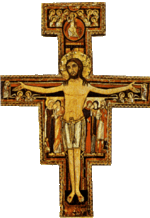Pope Julius II
| Julius II | |
|---|---|
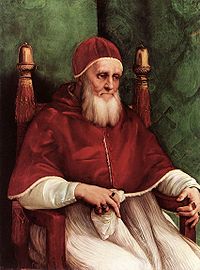 |
|
| Papacy began | 1 November 1503 |
| Papacy ended | 21 February 1513 |
| Predecessor | Pius III |
| Successor | Leo X |
| Personal details | |
| Birth name | Giuliano della Rovere |
| Born | 5 December 1443 Albisola, Republic of Genoa |
| Died | 21 February 1513 (aged 69) Rome, Papal States |
| Other Popes named Julius | |
Pope Julius II (c. 5 December 1443 – 21 February 1513), nicknamed "The Fearsome Pope" (Il Papa Terribile)[1] and "The Warrior Pope" (Il Papa Guerriero),[2] was born Giuliano della Rovere. He was Pope from 1503 to 1513. His papacy was marked by an active foreign policy, ambitious building projects, and patronage for the arts.
Contents |
Early life

There is disagreement about Julius' date of birth. Some sources put his birth as late as 1453.[3] Giuliano della Rovere was the son of Rafaello della Rovere[4] brother of Pope Sixtus IV[5] and of Theodora Manerola, a lady of Greek extraction.[6][7][8][9][10][11] Giuliano was an altar boy of his uncle Pope Sixtus IV (Francesco della Rovere). He was educated among the Franciscans by his uncle, who took him under his special charge and later sent him to a convent in La Pérouse with the purpose of obtaining knowledge of the sciences. However, he does not appear to have joined the order of St. Francis, but rather remained a member of the secular clergy until his elevation to bishop of Carpentras, France, in 1471; very shortly after his uncle succeeded to the papal chair.
He was promoted to cardinal, taking the same title formerly held by his uncle, Cardinal of San Pietro in Vincula. With his uncle as Pope, he obtained great influence, and he held no fewer than eight bishoprics (including Lausanne from 1472; and Coutances from 1476, along with the archbishopric of Avignon.
In the capacity of papal legate he was sent to France in 1480, where he remained four years, and acquitted himself with such ability that he soon acquired a paramount influence in the College of Cardinals, an influence which increased rather than diminished during the pontificate of Pope Innocent VIII. Shortly after in 1483 an illegitimate daughter was born, Felice della Rovere.
Accession to papacy
Rivalry grew over time between him and Cardinal Rodrigo Borgia, and on the death of Innocent VIII in 1492 Borgia was elected Pope Alexander VI. Della Rovere, jealous and angry, accused Borgia of being elected over him by means of simony and a secret agreement with Ascanio Sforza. He at once determined to take refuge from Borgia's wrath at Ostia, and a few months afterwards went to Paris, where he incited Charles VIII of France to undertake a conquest of Naples.
Accompanying the young King on his campaign, he entered Rome along with him, and endeavoured to instigate the convocation of a council to inquire into the conduct of the pontiff with a view to his deposition; but Pope Alexander, having gained a friend in Charles VIII's minister Briçonnet by offering him the position of cardinal, succeeded in defeating the machinations of his enemy.
Pope Alexander died in 1503, and his son, Cesare fell ill at the same time. Della Rovere did not support the candidature of Cardinal Piccolomini of Siena, who was (on 8 October 1503) consecrated under the name of Pope Pius III, but who died twenty-six days afterwards. Della Rovere then succeeded by dexterous diplomacy in tricking the weakened Cesare Borgia into supporting him. He was elected as Pope Julius II to the papal dignity by the near-unanimous vote of the cardinals (indeed, the only three votes he did not receive were those of Georges D'Amboise, supposedly his main opponent and the favourite of the French monarchy, and the votes of Cardinals Carafa and Casanova) almost certainly by means of bribery. His election only took a few hours.
Reign as Pope

Giuliano Della Rovere thenceforth took the name of his fourth century predecessor, Julius I. From the beginning, Julius II set himself with a courage and determination rarely equaled, to rid himself of the various powers under which his temporal authority was almost overwhelmed. By a series of complicated stratagems he first succeeded in rendering it impossible for the Borgia to retain their power over the Papal States. He then used his influence to reconcile the two powerful Roman families of Orsini and Colonna, and, by decrees made in their interest, he also attached to himself the remainder of the Roman nobility.
Being thus secure in Rome and the surrounding country, he next set himself to oust the Republic of Venice from Faenza, Rimini, and the other towns and fortresses of Italy which it occupied after the death of Pope Alexander. In 1504, finding it impossible to succeed with the Doge of Venice by remonstrance, he brought about a union of the conflicting interests of France and the Holy Roman Empire, and sacrificed temporarily to some extent the independence of Italy to conclude with them an offensive and defensive alliance against Venice. The combination was, however, at first little more than nominal, and was not immediately effective in compelling the Venetians to deliver up more than a few unimportant places in the Romagna. But, by a brilliant campaign in 1506, Julius succeeded in freeing Perugia and Bologna from their despots (Giampolo Baglioni and Giovanni II Bentivoglio, respectively), and raised himself to such a height of influence as to render his friendship of prime importance both to the Louis XII of France and the Holy Roman Emperor.
In 1506 he officially founded the Swiss Guard to provide a constant corps of soldiers to protect the Pope.
Holy League

In 1508, events so favoured the plans of Julius that he was able to conclude the League of Cambrai with Louis XII, King of France, Maximilian I, Holy Roman Emperor, and Ferdinand II, King of Aragon. The League fought against the Republic of Venice during the "War of the Holy League", also known as the "War of the League of Cambrai". Among other things, Julius wanted the Venetian possession of Romagna; Emperor Maximilian I wanted Friuli and Veneto; Louis XII wanted Cremona; and Ferdinand II wanted the Apulian ports.This war was a conflict in what was collectively known as the "Italian Wars".
In the spring of 1509, the Republic of Venice was placed under an interdict by Julius.[12] During the "War of the Holy League" and the "Italian Wars", alliances and participants changed dramatically. For example, in 1510 Venice and France switched places. By 1513, Venice had joined France.
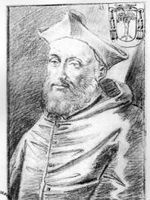
The achievements of the League soon outstripped the primary intention of Julius. By one single battle, the Battle of Agnadello on 14 May 1509, the dominion of Venice in Italy was practically lost. But, as neither the King of France nor the Holy Roman Emperor were satisfied with merely effecting the purposes of the Pope, the latter found it necessary to enter into an arrangement with the Venetians to defend himself from those who immediately before had been his allies against them. The Venetians on making humble submission were absolved at the beginning of 1510, and shortly afterwards France was placed under papal interdict. Attempts to cause a rupture between France and England proved unsuccessful. On the other hand, at a synod convened by Louis at Tours in September 1510 the French bishops withdrew from papal obedience, and resolved, with Emperor Maximilian's cooperation, to seek the deposition of the pope. In November 1511, a council met for this objective at Pisa.
Julius thereupon entered into the "Holy League of 1511". He allied with Ferdinand II and the Venetians against France. In short time, both Henry VIII, King of England (1509–47), and Maximilian I also joined the "Holy League of 1511."
Julius also convened a general council (that afterwards was known as the Fifth Council of the Lateran) to be held at Rome in 1512, which, according to an oath taken on his election, he had bound himself to summon, but which had been delayed, he affirmed, because of the occupation of Italy by his enemies.
Death and legacy
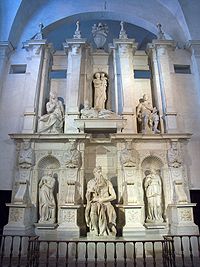
In 1512 the French were driven across the Alps, but it was at the cost of the occupation of Italy by the other powers, and Julius, though he had securely established the papal authority in the states immediately around Rome, was practically as far as ever from realizing his dream of an independent Italian kingdom when he died of fever in February 1513.
It is a common error that many associate the burial place of Julius as being in San Pietro in Vincoli as the location for the so-called "Tomb of Julius" by Michelangelo. However, this tomb was not completed until 1545 and represents a much abbreviated version of the planned original, which was initially intended for the new St Peter's Basilica. Instead, as was always intended, Julius was buried in St. Peter's in the Vatican.
His remains, along with those of his uncle, Pope Sixtus IV, were later desecrated during the Sack of Rome in 1527. Today, the remains of both lie in St. Peter's in the floor in front of the monument to Pope Clement X. A simple marble tombstone marks the site.
He was suceeded by Pope Leo X
Patron of the arts
While Julius II's political and warlike achievements would alone entitle him to rank amongst the most remarkable of the occupants of the papal chair, his chief title to honour is to be found in his patronage of art and literature. He did much to improve and beautify the city. In 1506 he laid the foundation stone of the new St. Peter's Basilica, and he was a friend and patron of Bramante, Raphael, and Michelangelo. Michelangelo painted the ceiling of the Sistine Chapel for Julius.
Character
Julius II is usually depicted with a beard, after his appearance in his celebrated portrait by Raphael, but the pope only wore his beard from 27 June 1511 to March 1512, as a sign of mourning at the loss of the city of Bologna by the Papal States, making him the first pope since antiquity to wear a beard, a practice otherwise forbidden by canon law since the 13th century. Julius shaved his beard again before his death, and his immediate successors were clean-shaven; however, Pope Clement VII again adopted the beard as a sign of mourning after the 1527 sack of Rome, and thenceforward all Popes were bearded until the death of Pope Innocent XII in 1700.
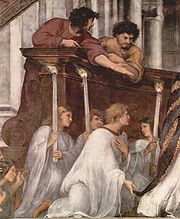
Julius was not the first pope to have fathered children before being elevated to the Chair of St Peter. His only known daughter to survive to adulthood Felice della Rovere was born in 1483. Pompeo Litta[13] mistakenly ascribed Felice's two daughters, Giulia and Clarice to Julius. Felice's mother was Lucrezia Normanni, the daughter of an old Roman family. Shortly after Felice was born, Julius II arranged for Lucrezia to marry Bernardino de Cupis. Bernardino was maestro di casa of Julius' cousin, Cardinal Girolamo Basso della Rovere.[14]
Despite an illegitimate daughter, rumors also surrounded Julius about his sexuality. Casting himself in the role of a warrior inevitably created enemies for Julius—many of whom accused him of being a sodomite. This was almost certainly done to discredit him but perhaps, in doing so, accusers were attacking a perceived weak point in their adversary's character. Venetians—who were opposed to the pope's new militaristic policy—were amongst the most vocal, most notably the diarist Giralomo Priuli,[15] and the historian Marino Sanudo.[16] The reputation survived him, and the accusation was used without reservation by Protestant opponents in their polemics against "papism" and Catholic decadence. Philippe de Mornay while he accused all Italians of being sodomites, added specifically: "This horror is ascribed to good Julius." These Protestant libels certainly lack credibility, just as do the Catholic libels which discussed Calvin's purported conviction for sodomy.[17]
Literature and film
Barbara Tuchman, in her book The March of Folly: From Troy to Vietnam,[18] offers a vivid narrative of Julius II's career. Her overall assessment of Julius is strongly negative, and she partly blames him for provoking the Reformation.
In the film The Agony and the Ecstasy about the life of Michelangelo, Julius is vividly portrayed as a soldier-pope by Rex Harrison. The film is a dramatization based upon the book of the same name by Irving Stone.
Episcopal titles
| Catholic Church titles | ||
|---|---|---|
| Preceded by Barthélémy Chuet |
Bishop of Lausanne 1472–1473 |
Succeeded by Benoît de Montferrand |
| Preceded by ? |
Bishop of Catania 1473–1474 |
Succeeded by ? |
| Preceded by Alain de Coëtivy |
Archbishop of Avignon 1474–1503 |
Succeeded by Antoine Florès |
| Preceded by Jean de Montmirail |
Bishop of Carpentras 1475–1476 |
Succeeded by Frédéric de Saluces |
| Preceded by Benoît de Montferrand |
Bishop of Coutances 1476–1477 |
Succeeded by Galeazzo della Rovere |
| Preceded by Hélie de Pompadour |
Bishop of Viviers 1477–1479 |
Succeeded by Jean de Montchenu |
| Preceded by Jean de Petit |
Bishop of Mende 1478–1483 |
Succeeded by Clemente Grosso della Rovere |
| Preceded by Berardo Eruli |
Cardinal-bishop of Sabina 1479–1483 |
Succeeded by Oliviero Carafa |
| Preceded by Alessandro Carafa |
Bishop of Coutances 1476–1478 |
Succeeded by Giovanni Bernardino Carafa |
| Preceded by Giacomo Passarelli |
Bishop of Bologna 1483–1502 |
Succeeded by Vincenzo Carafa |
| Preceded by Guillaume d'Estouteville |
Cardinal-bishop of Ostia 1483–1503 |
Succeeded by Olivero Carafa |
| Preceded by Jean de Corguilleray |
Bishop of Lodève 1488–1489 |
Succeeded by Guillaume Briçonnet |
| Preceded by Pietro Gara |
Bishop of Savona 1499–1502 |
Succeeded by Galeotto della Rovere |
| Preceded by Giovanni Stefano Ferrero |
Bishop of Vercelli 1502–1503 |
Succeeded by Giovanni Stefano Ferrero |
| Preceded by Pius III |
Pope 1503–1513 |
Succeeded by Leo X |
See also
- Art Patronage of Julius II
- Portrait of Pope Julius II (Raphael)
- Moses (Michelangelo)
- Julius Excluded from Heaven
Notes
- ↑ Blech, Benjamin; Doliner, Roy. (2008). The Sistene Secrets. New York, NY: HarperCollins Publishers. pp. 106. ISBN 9780061469046.
- ↑ Luminarium: Pope Julius II
- ↑ See http://www.catholic-hierarchy.org/bishop/brov.html
- ↑ "Julius II , POPE GIULIANO DELLA ROVERE.". www.newadvent.org. http://www.newadvent.org/cathen/08562a.htm. Retrieved 2009-07-06. "Born on 5 December, 1443, at Albissola near Savona; crowned on 28 November, 1503; died at Rome, in the night of 20-21 February, 1513. He was born of a probably noble but impoverished family, his father being Raffaelo della Rovere and his mother Theodora Manerola, a lady of Greek extraction. He followed his uncle Francesco della Rovere into the Franciscan Order, and was educated under his tutelage at Perugia."
- ↑ "Julius II". www.britannica.com. http://www.britannica.com/EBchecked/topic/307920/Julius-II. Retrieved 2009-07-06. "Giuliano was the son of the impoverished Rafaello della Rovere, Pope Sixtus IV’s only brother."
- ↑ Taylor, Robert Emmett (1980). No royal road: Luca Pacioli and his times. Ayer Publishing. p. 105. ISBN 0405135491. "Giuliano was born on December 5, 1443, at Albizzola, near Savona, the son of Raffaelo, a brother of Sixtus rv, and of Theodora Manerola, a lady of Greek extraction."
- ↑ Cronin, Vincent (1969). The flowering of the Renaissance. Dutton. p. 33. OCLC 32545. "his father, Raffaello della Rovere, being a brother of Sixtus IV, his mother, Teodora Manerola, of Greek origin."
- ↑ Roterodamus, Erasmus (1986). Collected works of Erasmus. University of Toronto Press. p. 496. ISBN 0802056024. "(Julius II) mother was a Greek named Theodora Manerola"
- ↑ "Pope Julius II.". www.catholicity.com. http://www.catholicity.com/encyclopedia/j/julius_ii,pope.html. Retrieved 2009-07-06. "his mother Theodora Manerola, a lady of Greek extraction"
- ↑ Symonds, John Addington (1925). The life of Michelangelo Buonarroti: based on studies in the archives of the Buonarroti family at Florence. Macmillan. p. 383. OCLC 27216292. "TEODORA, dr. of Giovanni Manirolo, of Greek origin"
- ↑ Fusero, Clemente (1965). Giulio II. Dall'Oglio. p. 53. OCLC 8809014. "Giulio Il virtuoso Raffaello della Rovere ha sposato una donna di origine greca: Teodora di Giovanni Manirola."
- ↑ Venice Excommunicated, History Today
- ↑ Litta, "Famiglie Celebri Italiane" (Celebrated Italian Families), 1833
- ↑ A definitive life of Felice della Rovere is in Caroline P. Murphy's The Pope’s Daughter: The Extraordinary Life of Felice della Rovere. Oxford University Press, New York. 2005
- ↑ G. Priuli, Diarii, in Rerum italicarum scriptores, Vol 24, Bologna, 1938.
- ↑ M. Sanudo, I diarii, Venice 1879-1902
- ↑ P. De Morney, Le Mystere d'iniquite, c'est a dire, l'histoire de la papaute, 1612.
- ↑ [1984; ISBN 0-345-30823-9]
References
- Text from the 9th edition (1880) of an unnamed encyclopedia (Two 127 year-old bibliographic references omitted).
- P. De Morney, Le Mystere d'iniquite, c'est a dire, l'histoire de la papaute, 1612.
- G. Priuli, Diarii, in Rerum italicarum scriptores, Vol 24, Bologna, 1938.
- M. Sanudo, I diarii, Venice 1879-1902.
- R. Aldrich & G. Wotherspoon (Eds.), Who's who in Gay and Lesbian History, London 2001.
External links
- Luminarium: Pope Julius II
- Pope Julius II at Find-A-Grave
- "Julius Excluded from Heaven" (1514) Satire attributed to Desiderius Erasmus.
|
|||||||||||||||||||||||||||||||||||||||||||||
|
|||||||||||||||||||||||||||||||||||||||||

